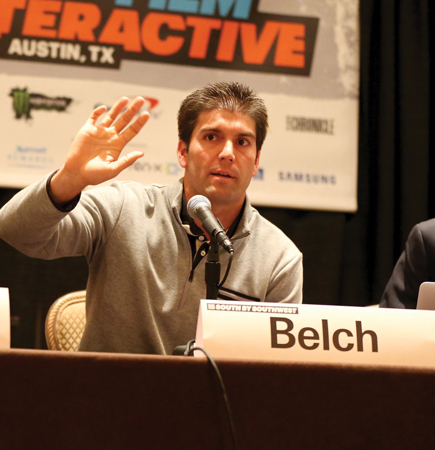A panel of media industry veterans who make their living in virtual reality believe the technology is primed for mass adoption, despite the many challenges it faces.
“It’s a process. It’s not there yet,” said Michael Davies, senior vice president of technical and field operations for Fox Sports.
Davies and other virtual reality executives took part in a recent panel session moderated by former NBA Commissioner David Stern. The event took place in New York at the Paley Center for Media.
The panelists agreed that the biggest obstacle to virtual reality’s success is the bulky headset users have to wear to
 |
Strivr’s Derek Belch, shown at an earlier event, said that the size and weight of headsets limit opportunities.
Photo by: Getty Images |
best experience the technology. If consumers shunned 3-D television because they had to put on special glasses, what makes VR executives think they will put on a full headset?
Currently, the headset is so bulky that people generally experience virtual reality for only a couple of minutes at a time. People aren’t watching full games in virtual reality, something executives attribute to the size and weight of standard headsets.
Case in point is the training software Strivr Labs developed to help athletes train more efficiently, giving a quarterback, for example, a virtual view of the defenses he might face. Last year, the longest session any football player had during such a training session was only 12 minutes, Strivr CEO Derek Belch said.
“The elephant in the room is the headsets,” he said. “That headset has a long way to go before someone’s going to hang out in it for hours and hours based on what we’ve seen.”
NextVR Executive Chairman Brad Allen preached patience. He said technology is improving so quickly that the virtual reality applications of today will look wildly different five years from now.
“These things are heavy, they’re bulky, and they’re hot,” he said. “Forget that. That’s like saying that the brick cellphone we had can’t fit in my pocket. These things are going to be like a pair of Oakley glasses. They are going to Bluetooth from your mobile device. They are going to be full HD. … There’s a ways to go, but it’s happening fast.”
The problem is that bad experiences today can hurt consumer adoption down the road. Belch said one unnamed NFL coach will not meet with Strivr because of a bad experience he had with virtual reality eight years ago.
“Eight years!” Belch said. “[Virtual reality] is going to be incredible in eight years. It’s not going to look anything like it is today. But we’re being punished for something eight years ago.”
More questions center around who owns virtual reality rights. When networks started to produce games in high definition, they did not have to pay more for HD rights. When they dabbled in 3-D, leagues started looking into rights payments, but they never did because nothing of scale was produced.
But executives believe that placing a rights fee on virtual reality could impede its progress. All the leagues are now testing it out, which is what Stern said is the smart thing to do.
“I would say, ‘Go ahead and try it’ because all it’s going to do is bring us more fans,” the former commissioner said. “But it’s not here yet. Something is here. But that holy grail is not yet here.”
That holy grail can be achieved through more compelling content, executives said. NextVR’s Allen said the bulkiness of virtual reality headsets did not dissuade people from watching all 35 minutes of the keynote speeches during its developer conference, Oculus Connect.
Currently, though, consumers are using virtual reality to check into an event for a few minutes before returning to the television telecast.
“At the moment, you have your glasses to your side and you’re dipping in and out,” Davies said. “With the technology on the consumer side, that’s about as much as anybody can take. In the future, how to synthesize that with your linear broadcast — I’m just not sure yet.”
Davies believes that virtual reality will serve as a complement to the television production.
“We’re not looking for VR to replace the traditional broadcast,” he said. “The audience requires a story to be told. … We pay some money for our producers and directors. They’re really talented. Ultimately, you want to maintain that part of the broadcast.”




